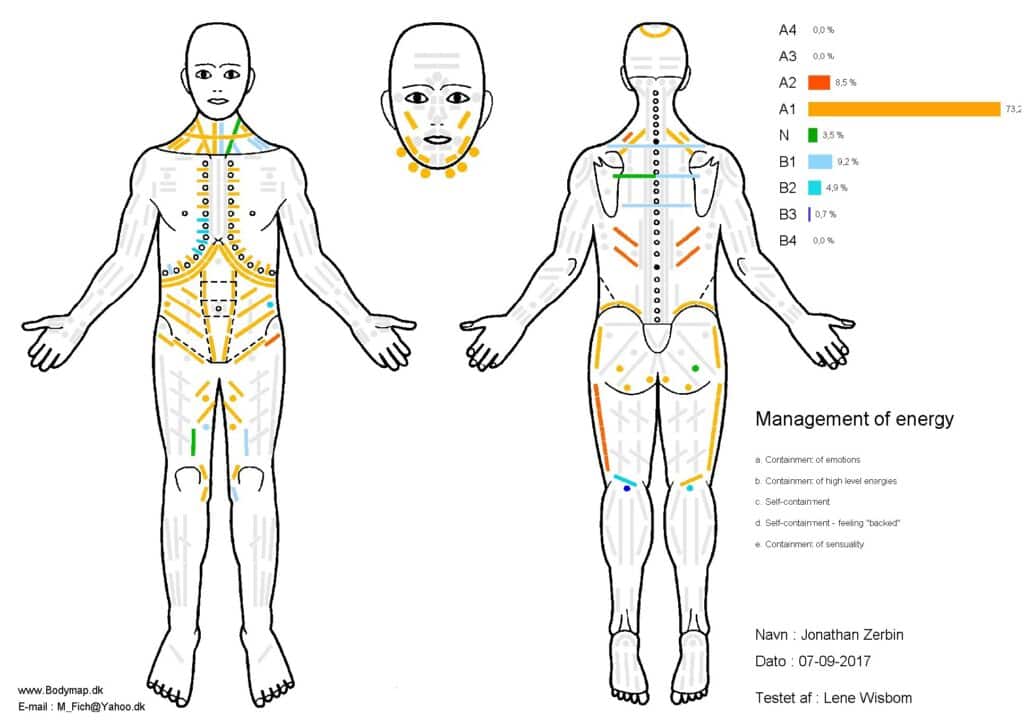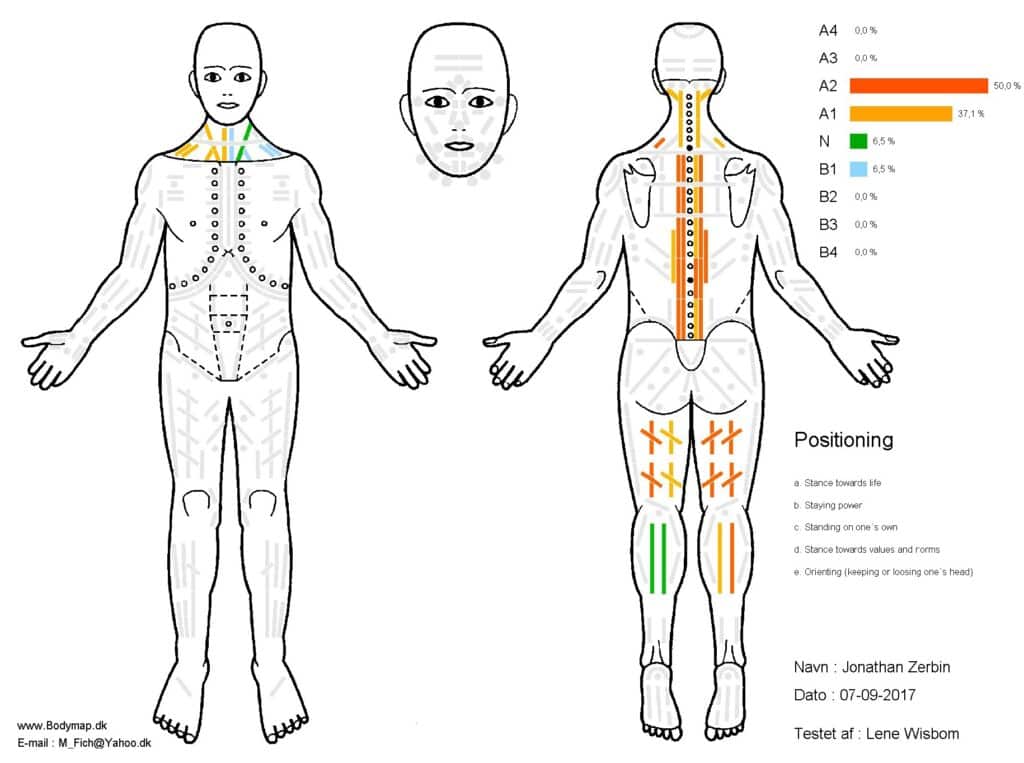Paradoxical HRV & Training HRV with a Lief

Recently at the gym, I was showing my personal trainer all the metrics my Oura ring tracks. As I was showing him my data, he remarked on how low my HRV was. My HRV had averaged about 26ms through the night for the past few months. I thought wrongly, that a low number was a good thing, like heart rate. Turns out I am near the very low end of the scale and that a higher HRV number closer to 70-120ms is considered a sign of good health. He said that when he was tracking his HRV regularly with a whoop band that he would average 70-120, and would only get into the 20ms range when he had a lot of beers the night before, had subsequent terrible sleep and a rough time the next day.
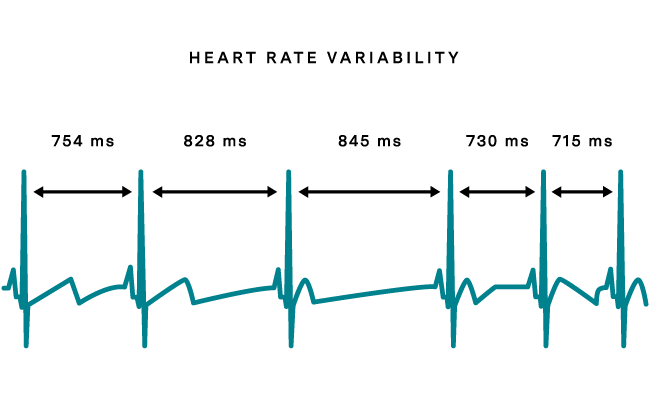
Heart Rate Variability (HRV) is the variation in time measured in milliseconds (ms) between heart beats. It is very important to differentiate this from heart rate, as heart rates measure beats per minute. HRV is an independent variable. You can have wildly different HRV at 60bpm. You can have 60bpm and 80 bpm and have the same HRV. With HRV we are not concerned with bpm.
HRV is a proxy for the state of the autonomic nervous system. A low HRV number is a sign of sympathetic arousal, and a high HRV is a sign of parasympathetic activation. A high HRV is a sign the autonomic nervous system can more easily adapt to stress and switch to “rest and digest” more easily. The parasympathetic branch of the autonomic nervous system is controlled by the Vagus nerve. Poor HRV is a sign of poor vagal tone.
There is no scientific consensus around precise numbers of HRV and what is considered “healthy”. Generally though it is though that:
- <30ms is not good
- 30 – 50ms is ok
- 50 – 70ms is good
- 70ms+ is great
I checked my data going back 6 years, since this is how long I have had my Oura ring (gen 2 and gen 3), and my HRV was a consistent ~28ms average across those 4 years. Then I cross referenced it with my Eight Sleep pod cover, and it also confirmed in the 6 months that I had been using it my HRV was averaging about ~29ms through the night. I checked my partner, and she had averaged 50ms, nearly double mine in a similar time frame! I remarked to my personal trainer, waking up not feeling rested, like a bad hangover is how I wake up every morning and have for decades….this is my Chronic Fatigue Syndrome (CFS). I have never known what it’s like to wake up feeling rested and rejuvenated. For all my life when I wake up from naps or night time sleep, I am considerably more exhausted than before them.
This is the first time in all of my CFS journey I felt like I had a solid measurable data point that showed there was something wrong with me, as every other medical test I had ever done showed me to be in apparent excellent health.
This started me down a journey of trying to figure out what I could do about my HRV. Fortunately this is a pretty well developed field, and there are many biofeedback devices and breathing exercises that can help you train to improve your HRV.
The frustrating thing when trying to research “HRV training” or apps there are two types:
- Planning your physical training exercise around your HRV. Athletes do this to optimize their body’s need for rest and recovery, and use HRV to determine when to train and when to rest. Good video on this here: https://www.youtube.com/watch?v=ozcZSnjbPoE
- Training your HRV using biofeedback and/or breathing exercises. This is about using the breath to help tune your autonomic nervous system to improve Heart Rate Variability
I was purely interested in the 2nd option.
HeartMath – shortcoming
One of the oldest and most well known organizations focusing on HRV is HeartMath (founded in 1991). Over the last several decades they have come out with numerous devices that can help you “train” your HRV by practicing deep breathing. This is the first thing I wanted to try out.
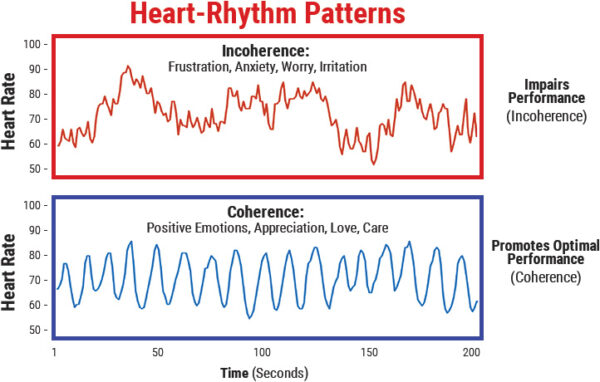
From what I gather the goal here isn’t to increase your HRV per se, it’s more about improving coherence. Coherence being a nice sinusoid looking waveform of your HRV. Maybe having greater coherence is supposed to increase your HRV!? I’m not sure on their philosophy, I just find it odd that improving HRV is not a stated objective of theirs. They seem to be more interested in romantic notions of symmetry and resonance, than increasing baseline HRV scores.
The whole HeartMath approach is more oriented to emotion, transform the world through the love of your heart. Having bought their most recent device the “Inner Balance Coherence Plus” and done their program via their app, I found it to be very spiritual bypass like. I’m not the biggest fan of their approach. Contrary to the breath guidance around focusing on the heart, I personally found that focusing on feeling my emotions in my abdominal muscles would give me a higher coherence score.
What disappointed me about the Heartmath device is that it does not try to synchronize your breath with your heartrate. It appears there is only one device on the market that is capable of doing that, and that is the Lief which I will get to later.
I practiced HeartMath daily for a couple of weeks achieving decent Coherence scores. The HRV reading the device was giving me was a sinusoid between 50 – 70ms. However I was deeply suspicious of this number, knowing what my night time HRV was like.
I wanted another way to test my HRV, and used the Mediation function of my Oura ring, concurrently while doing HeartMath breathing exercises. The results from both apps are as follows, and the data shocked me. Specifically the one from the Oura ring.
HeartMath Results:
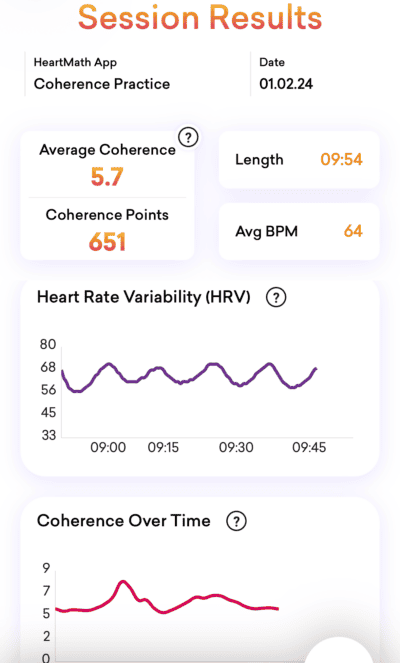
Oura Ring “Mediation” Results:
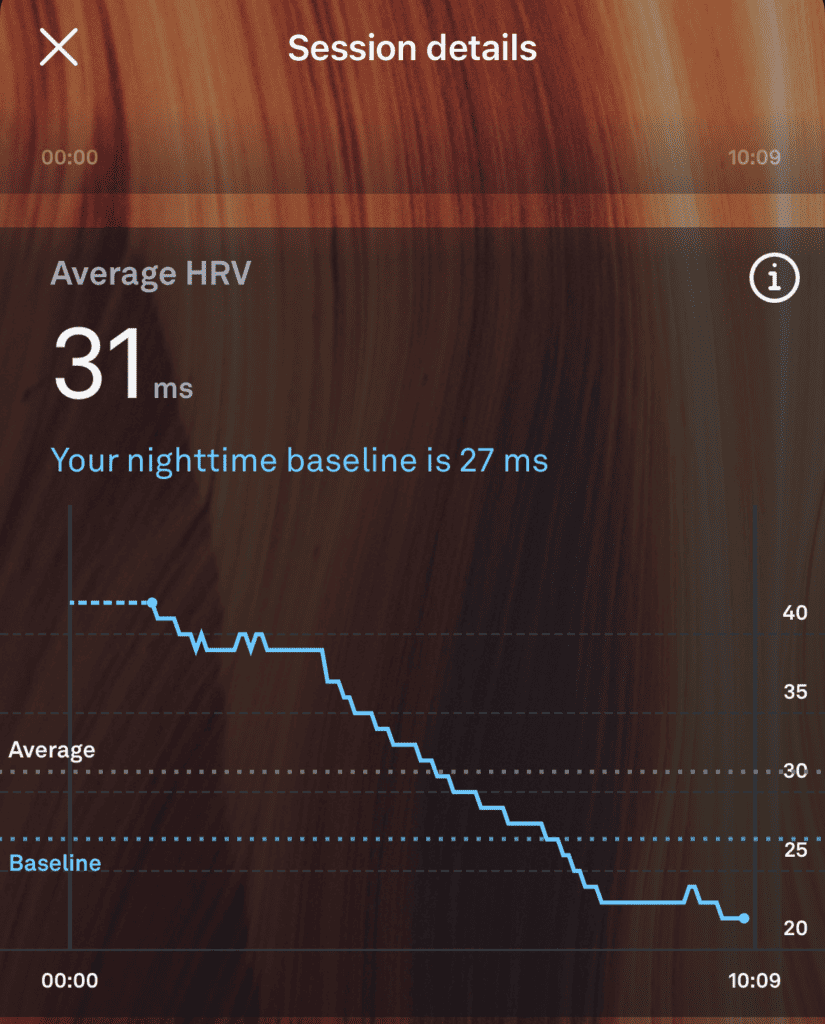
In case it’s not obvious, the Oura Ring showed that I started the HearthMath breathing exercises session at about 40ms, and by the end dropped down to 20ms. Meanwhile the HeartMath showed I had a respectable coherence score of 5.7 and an HRV that supposedly never dipped below ~56. There was a clear conflict between these two results measured over the same time interval, and I was more inclined to believe the results form the Oura ring.
What that meant however seemed paradoxical, because by doing a relaxing breathing exercise where I physically, emotionally and mentally felt calmer, my autonomic nervous system became progressively more stressed out.
Another reason for my suspicion was that looking at my HRV data a few nights before from my Oura ring I saw a perplexing trend:
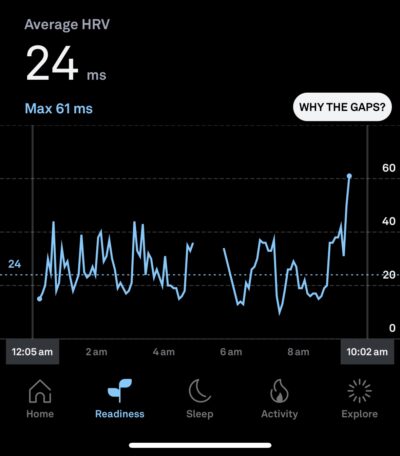
Looking at the data, it seems clear that when I’m sleeping and am at my hypothetically most relaxed state of the day my HRV goes into really low territory and that as I begin to wake up, my HRV increases. Again this is the opposite of what is considered “normal”.
If this is true, then it would appear that my autonomic nervous system is cross wired. That by sleeping or sitting still doing meditative breathing exercises, triggers my autonomic nervous system into sympathetic arousal! I needed more accurate data to resolve the conflict between HeartMath device and my Oura ring.
Lief – success
The Lief HRV monitor and biofeedback device is one of the most accurate devices on the market you can buy for measuring HRV. It’s a small flat white device you attach with two sticky electrode patches to your chest area near your heart. This gives medical grade ECG readings for very precise data collection. After having such conflicting results with HeartMath and my Oura ring, I wanted to have something that I could have strong confidence in. Other devices like the Whoop band, Apple Watch, Fitbit and more were too much of a compromise in terms of accuracy for me.

The Lief is by far the most cumbersome device to wear out of all the popular HRV monitors out there. Wearing sticky electrode patches 24/7 is irritating to the skin, and using the chest strap alleviates that issue, but then if you move around a lot the electrodes loose contact and need to be frequently re-wetted.
The benefit of the Lief is you have the most accurate HRV data possible nearly 24/7. You do need to charge it for about 1.5 hours a day to last the next 22.5 hours. Unlike the Oura ring which only measures HRV at night, with Lief you can see what your HRV is in real time as you go about your day.
So I decided to go for it. And was very curious to see what the data would show.
As soon as I got it, I charged it and put it on. The device goes through about a 6 hour calibration period where it determines your personal HRV range so that the app can set appropriate thresholds to help you for training. Every person has their own baseline average HRV.
My first real test was taking a 20 minute nap, to see what would happen. Prior to my nap I was averaging maybe 25 – 35ms just walking around sitting at my desk and doing work stuff.
I lay down and my HRV increased slightly to 35ms as I went into a deep state of relaxation. I kept my phone propped up so I could periodically open my eyes and check on my HRV. I closed my eyes for a few minutes, relaxed further and then glanced at the app and saw the following.
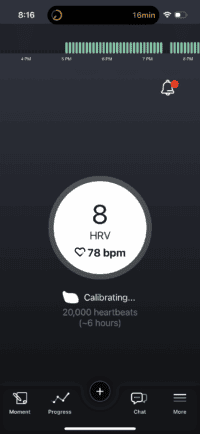
The result above speaks for itself. I shut my eyes again for a few more minutes, opened again, and checked periodically over the remainder of my nap. It stayed at 8ms for most of the period dipped to 7ms at one point and never went above 10ms. I wasn’t anxious, stressed out, mind racing, etc. I was very relaxed, yet here my HRV was clearly crashing. This confirmed the result I got from the Oura ring while tracking the “mediation” sessions.
The next test for me was to check what happened at night. And the result is as follows from wearing the Lief for my first night.
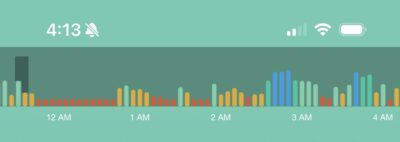
Correlating this with my Oura ring sleep data I fell asleep at 11:42pm and woke up at 4:13am. It appears that during the earliest and deepest parts of my sleep the deep sleep stages my HRV absolutely crashes. Later on in my sleep as I enter REM state my HRV improves.
For reference the bars above are:
- Red <15ms
- Orange 15 – 25ms
- Green 25 – 30ms
- Blue 30ms+
Over the next couple of weeks while wearing the Lief device this is what I noticed in general so far:
Things that cause my HRV to plummet quickly to <15ms:
- Napping
- Sleeping; the early deepest stages specifically
- Standing Still; as in brushing my teeth, or making food in the kitchen
- Lying on the couch in a very reclined/relaxed position watching a tv show
- Sitting cross-legged mediating doing breathing exercises
- Sitting at my computer in a chair with both feet on the floor, calmly focusing on something
- Sitting at the dinner table eating a meal
- Vigorous exercise (this is the only one that is normal here)
Things that keep my HRV in my normal range 25 – 35ms:
- Sitting awkwardly in my chair, usually on a foot, or on my shins
- Sitting awkwardly on the couch, legs up in some sort of stretched position
- Being actively engaged (moving my body around) talking with someone, usually no matter the position
- Being actively engaged with a task sitting at my computer
- walking around the home/office being lightly active
Things that improve my HRV beyond normal range 35 – 90ms+:
- Breathing exercises with the Lief App and device
- Stretching
So far I don’t know what to make of these results. The only conclusion I can come to is that my autonomic nervous system is paradoxically cross-wired and that the things that normally increase a person’s HRV have the opposite effect on me. Further down this post I will explore some hypothesis I came up with.
Concrete things that improve HRV
Breathing Exercises via App
Lief is the only product on the market I am aware of that times your breath very specifically around your HRV and heartbeats in real time. This is the primary unique advantage of the device, and in my opinion makes it better than anything else out there; say compared to HearthMath, the Whoop, Fitbit, Oura ring, etc.
Using the Breathing Exercise via the app, is the single fastest way to improve HRV on the spot whenever necessary. It really is quite remarkable that it is so effective.
Simply doing deep breathing without the app can also work, sometimes….. Sometimes it does nothing, or even makes it worse. When doing it with the app which times your breaths very precisely with your heart beats, it will work 95% of the time at improving HRV. The only time I found that it wont work, is if you can’t relax your muscles during the breathing and keep holding tension in your body. Personally this is the case for me when standing.
To get the the most effective use out of the device, you can’t quite just use it like a magic pill, and follow the directions like autopilot. You need to be actively engaged in sensing muscular tension patterns in your body, tuning into those, and relaxing them in conjunction with the timed breathing. This is the most challenging and important part of HRV training. It is subtle work, it requires of you to become aware of very subtle tension patterns. Training awareness of the sensing of your body, specifically muscles is key here. Having any kind of somatic psychology training is going to be a big advantage here.
If you are anxious, and focused on an emotional feeling/story in your head, and not really connected to and sensing your body, and your body is tense, the breathing exercise is going to have limited benefit. It will still likely work, you can almost brute force it, but this will require far more hard work over a longer period of time.
The next two images are screenshots from the synchronized breathing exercise from the app. The first image shows what it looks like while doing the exercise, the second image is the best result I got so far from just doing a 2 minute guided breathing exercise.
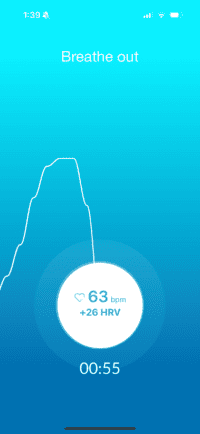
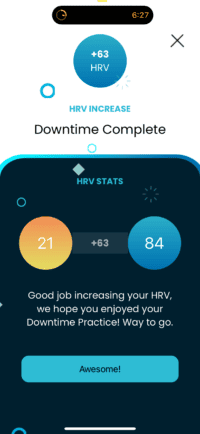
The fact that I can with a 2 minute breathing exercise increase my HRV four fold from 21ms to 80ms+ is really incredible. The Lief device has exceeded my expectations and I am very grateful to have access to this technology.
The main trick to improving HRV
Using the Lief device is a phenomenal way of tracking in real time what lowers and increases HRV. With the breathing exercise in the app, it shows you concretely if and when your are gaining HRV and when your losing HRV. Almost all the gains in HRV occur during the out-breath; the exhale. HRV will sometimes increase a little by 1 – 3ms on the inhale but usually it remains flat. On the exhale is when HRV gains are seen the most, if exhaling properly. I have seen gains are anywhere between 2 – 12ms on a single exhale.
The trick with the exhale seems to be how much can you relax all the breathing muscle involved with the exhale. If the exhale is forced, with lots of tension in the belly, diaphragm, neck and jaw then gains in HRV are negligible or none at all. Conversely if you focus on at the start of the exhale relaxing the belly, then the diaphragm, then the chest muscles, specifically the intercostals, then the neck, and finally the jaw as the the air moves up and out, this seems to be the golden recipe for seeing the largest gains in HRV. The exhale is ideally slow enough that it gives you time to sense the relaxation in all the muscles. If you slow the exhale down too much, that you introduce tension then this will be counter-productive. Getting this just right takes some training. If you can focus on the sensations of relaxation on the exhale, eventually this becomes more natural.
Which leads me to wonder if a lot of people who experience poor HRV are just to tense in their breathing muscles on exhale? I found that doing this sitting or lying down to be most effective. Doing the breathing exercise standing, seems to give far inferior results, maybe because the muscles ideally relaxed need to be tense in order to stand upright.
Early Promising Results
After a week, and a solid day of really paying attention to my HRV and doing 20 – 30minutes of HRV breathing exercises throughout the day I had my my first night’s sleep where my HRV didn’t dip below 20ms.
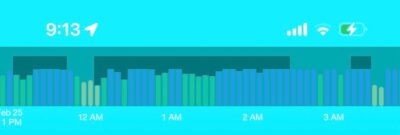
My Oura ring also showed an improvement to a night average of 34ms, which is the highest I had ever seen in 6 years. At this point I can really notice the difference in my energy during the day and how rejuvenated I feel upon waking. The difference between 26ms and 34ms is significant as this is a 26.7% improvement. I have to say I was initially skeptical that staying vigilant about my HRV during the day, and keeping it up, would magically result in higher HRV during the night but the results speak for themselves.
The longer term trend is also looking promising which provides me with extra motivation to keep going.
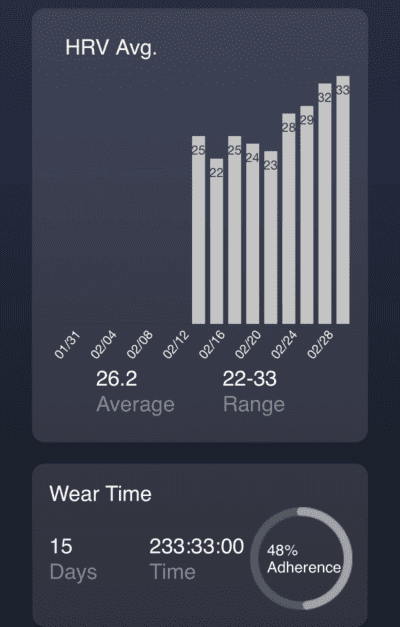
According to some clinical studies (reference needed) 5 weeks of diligently doing a minimum of 10 minutes a day of targeted breathing exercises can increase baseline HRV by 25%. This is very impressive, and a goal I am setting for myself.
I have noticed that after doing this for 2 weeks, when I do the breathing exercises now, gains in HRV are becoming increasing larger. With the Lief you can set thresholds, so when falling below a certain HRV the device vibrates, guiding you through something called an “auto-dose” where you breathe until your HRV is at the level you set your target threshold at. This is a pretty cool feature, which thus allows you to tightly regulate your HRV.
What’s fascinating about all of this is that vagal tone definitely seems like something that is highly trainable. I find this exciting and hopeful, and I am very curious to see how high I can train my HRV and what the improvements in my wellbeing will turn out to be. From the clinical studies training gains seems to build on themselves and results are sustainable and persist.
This does take some work, likely 20-30mins a day of guided breathing, and watching HRV closely all day and avoiding too many triggers.
Stretching
Stretching for me is another incredibly reliable way to increase HRV. 5 minutes of stretching can easily increase my HRV my 10-20ms or even more. The fact that stretching is so effective, seems to indicate that low HRV is associated with excessive muscular and fascia tension in the body. Stretching seems to give more “room” in the body, and signals a sign of safety and that the body can begin to relax at an autonomic nervous system level.
The tension I experienced in my body from sleeping was so bad I even built myself a stretch gym with a stretch cage. I now use it to stretch before sleep, halfway through the night and upon waking. I also use a bench and weights to do weighted stretches.
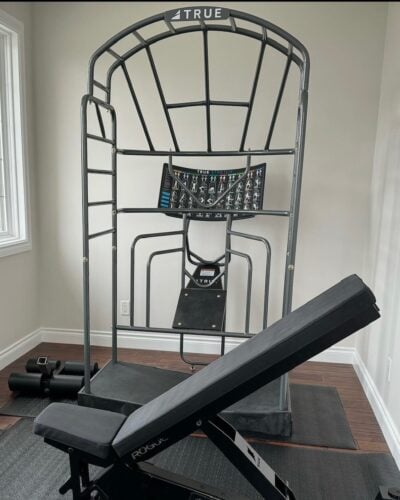
Vagus Nerve Stimulators
Other devices that I would like to experiment with are direct Vagus nerve stimulators. There are a large number of these on the market now. I feel unsure about using such a brute force approach to improving HRV and wonder how sustainable long term results of doing this would be. It seems like a band-aid kind of magic pill solution as opposed to addressing a potential root cause.
The two that caught my eye are the:
Possible Causes for Paradoxical HRV
Background Health Issues
What causes my HRV to crash often when sleeping or sitting still and with near certainty while standing still is a huge mystery to me. As I wear my Lief I keep gaining new insights. At this point I can only speculate.
First of all I have several underlying conditions. Chronic Fatigue Syndrome and Fibromyalgia which I have had in a moderate to severe form since I got sick with a virus once when I was 16. Until this point I had assumed the cause was an overuse of antibiotics when getting ill (in case it was bacterial), which caused a pervasive fungal infection. Read more about what’s helped me with that here. I also have orthostatic hypotension, which means if I change my vertical position too rapidly I can get dizzy. This may also be connected.
How much energy I have during the day is highly contingent on how well I sleep the night before. And if my HRV is crashing at night and staying extremely low during the deepest part of my sleep, it’s hard to imagine how sleep like that could be restful. The few nights I have had where my HRV does not crash into red territory, I have markedly better energy during the day, which leads me to believe that perhaps my CFS and fibromyalgia is caused by low HRV. I have had insomnia type issues my whole life. Night terrors, bad dreams at night, fear of rolling out of bed mid sleep and hurting myself as a child, and persistent bruxism/teeth-clenching (a sign of emotional distress) such that I wear a nightguard.
My body becomes so tense at night when I sleep I have resorted to biphasic sleeping, where I sleep 4 hours, wake up for 2 hours, rest, eat and stretch then go back to sleep for another 3 hours. If I try sleep 7 hours in a row the tension gets so bad it feels like I was hit by a semitruck upon waking.
During the day I am emotionally very well contained, at night however my dreams can take me on a wild ride, and I can have a large amount of anxiety and uncontained emotional turmoil with little or no memory upon waking. I had thought perhaps it was unprocessed emotions from the day that were then getting processed at night that was throwing my nervous system off balance. Maybe I am overly repressive somehow.
This also presents a chicken or the egg problem. Are unprocessed emotions causing my autonomic nervous system to go out of whack, or is an out of whack autonomic nervous causing a bunch of unnecessary emotional turmoil while I sleep?
Is perhaps the cause to and out of balance autonomic nervous system a nutritional deficiency, or neurotransmitter deficiency of some kind? Taking magnesium threonate has had a significant positive impact on both my CFS and fibromyalgia. Taking 10-20grams a day of BCAA’s has also had a significant positive impact on my Fibromyalgia. Do I have a dopamine deficiency, due to a double COMT mutation? Phenylalanine has benefited me some, I have yet to try Tyrosine or even Adderall.
One thing I have noticed is that fatigue makes my HRV worse. If I had a psychologically stressful day, or even a physically intense workout it will be a lot harder for me to keep my HRV up, and when I do lie down to rest it crashes much faster. This can create a kind of negative feedback loop. Exhaustion leads to poor HRV, especially during rest, I don’t get good rest, which leads to further exhaustion, which leads to worse HRV, etc. A bad night with low HRV is a recipe for a ruined day I can virtually do nothing about, and I basically need to wait until the next night to hope I get a better one. It often feels like I’m playing Russian roulette with my nights, will my HRV tank or will it not when I enter deep sleep. Same goes for naps.
Adverse & Traumatic Childhood experiences
As an infant I had very irregular sleep, preferring to be awake at night and was colicky. My mother also followed the traumatic parenting philosophy of the time that one shouldn’t hold a baby too long, and best to let them cry themselves to exhaustion so they can learn to “self-soothe”. Knowing this about my early past my first hypothesis is that that perhaps my nervous system associates lying still with disconnection and threat to my survival, and that this is perhaps the root cause of all my insomnia issues. Self-regulation is learned through co-regulation, and with poor to non-existent co-regulation, self regulation is never properly learned.
This leads me to several possible conclusions. One is that normally when an infant is distressed, you pick them up and rock them. Close physical contact plus motion let’s them know they have contact and are alive and their nervous system can calm down. Paradoxically you are stimulating the infant with motion and contact, to help them become more calm. So in order to emulate that, some of the first things I thought of that could be therapeutic, were periodically using things like massage/vibration pads, shakti acupressure mat & massage chair. One of my colleagues even recommended getting a Chi machine and doing vestibular training. These devices can only be used short term however, and I can’t exactly do a full night’s sleep on them, but I thought maybe they can help retrain my autonomic nervous system to get the message being still isn’t a threat to my survival.
What I could potentially sleep on is a sound bed, something that gives subtle vibrations for my entire sleep. Ironically the Opus Sound Bed which I am considering getting is marketed to help generate greater emotional fitness.

Because there is a very strong postural – stillness component to putting me into high sympathetic arousal, one other thing that came to mind is perhaps there is something with my reflex system that due to my experiences as an infant remains unintegrated. I plan on going for a Masgutova Neurosensorimotor Reflex Integration (MNRI) assessment as soon as possible to see if this could be the case. One of the best ways to access the autonomic nervous system outside of the breath is to work directly with the bodies reflex system. Even working with the breath such as using the Lief device and app is technically working with the breath reflex system.
The autonomic nervous is what takes over in situations of trauma when the voluntary nervous system becomes overwhelmed. It makes me think I may have some sort of early form of PTSD, where by being still (sleeping, sitting or standing) it puts my nervous system into a sympathetic survival freeze response of some kind. If this is true, then how to work with this? For adult PTSD traumas the way this is worked on in the Bodynamic system and Somatic Experiencing is by activating the running reflex, to run away from the traumatic event to safety before the event occurs. In my case there is nothing to run away from.
Two other possible adverse childhood experiences come to mind that could have had an effect. The first was I grew up in a highly fundamentalist religious household. I was required to sit in church for long hours many times a week, absolutely still, and also stand in prayer absolutely still. As a child this is torture, but if not done would entail severe physical punishment. It’s possible in order to behave I did something to myself psycho-physically in order to keep myself still.
As a family we also took long road trips every summer, that required sitting in a vehicle 8 hours a day for several days on end to make it to the destination as fast as possible. Again torture for a young child. To this day the idea of long road trips or even getting into a plane is highly aggravating.
To this day I have many dreams about my personal autonomy being challenged, mainly thematic dreams about car problems and trying to find my car (autonomy) in large parking lots. Also dreams about being in a car that is going to fast, and the brake pedal and gas pedal are not working properly. The brake pedal doesn’t work or only partially works, and the gas pedal makes me go to fast and I lose control. Highly symbolic of what’s actually going on with my autonomic nervous system. I also have many dreams of the wheels being stolen off my car, or the doors, which is emotional language for my autonomy being stripped of me causing very high levels of night-time anxiety.
Psycho-motoric Developmental coding’s
How might these adverse childhood and traumatic experiences show up in my body and subsequently in the autonomic nervous system? There are some additional clues from a system I have been training in as a practitioner for the last ten years called Bodynamic Somatic Developmental psychology. In the system you learn how childhood experiences are psycho-motorically coded in the body during the primary stages of childhood development, in-utero until age 11. You can see an early self-analysis I did on myself via a Bodynamic Bodymap here.
A more recent Bodymap I had done in Denmark gives some additional clues that seem to tie in thematically with what’s going on for me. Here I present two selected portions of a a Bodymap, one of the Ego Function Energy Management and the other of the Ego Function Positioning.
The relevance of the first map on my ability for Energy & Emotional Management has to do with the uniformity of the colour orange (A1) that is coded for the muscles on the front of my torso. Recent developments in Bodynamic understanding state that if greater than 70% of muscles in an ego function are one colour it is an indication of developmental trauma. The impact of this particular kind of trauma is that the ego function becomes psycho-somatically locked in and becomes very difficult to access with the felt sense as it lacks psychological polarity. Sufficient polarity is necessary to have internal reference points to use the functional aspects appropriately. In this case the majority of my breathing muscles which are directly connected to the autonomic nervous system are coded A1. This is where there is an overlap between the autonomic or involuntary nervous system and the voluntary one.
The implications of this is that working with breathing and or emotions is extra challenging because the voluntary nervous system is largely all in one state. That being in a 24/7 low sate of arousal. What to do about this? The Bodynamic way is to come at it sideways through an ancillary ego function such as Boundaries. I won’t get into the details of that as it’s beyond the scope of this article and would require it’s own long blog post.
In terms of postural issues being a trigger for my autonomic nervous system and HRV, the second map shown above of the Ego Function Positioning which may be relevant. Out of all my Ego functions this one has the most red in it, which is a sign of higher than normal levels of tension. It’s possible that muscles here, especially around the spine, or psycho-somatically so tense it’s having an adverse effect on my autonomy and mobility which trigger my autonomic nervous system quickly into sympathetic freeze-like arousal leading to crashing HRV. Bodynamic therapy has a number of strategies on how to work with this that are more accessible which involve lots of stretching and spine movement like exercises.
To summarize the Bodynamic Bodymap sheds some light on possible things I did to myself psycho-somatically to contain and deal with adverse childhood experiences and possibly trauma. Knowing precisely how this impacted me gives me a more wholistic and greater understanding of what is going on with myself and can potentially give me extra ways to come up with strategies to resolve the underlying issues.
Helpful Resources
- The following video with Richard Gevirtz, Ph.D., is exceptionally informative and inspiring in regards to biofeedback training to improve HRV.
- The Youtube channel HRVHackers has also been interesting and where I first learned about the Lief device.
- Polyvagal theory was developed out of research into HRV by Dr. Stephen Porges – Heart Rate Variability: A Personal Journey

